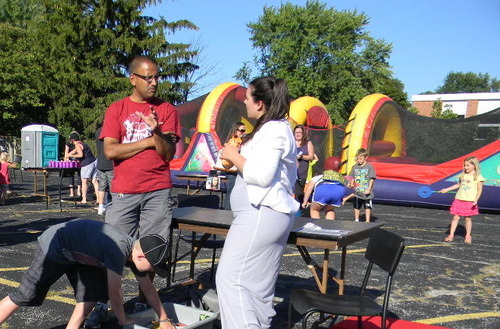More Than Fair
Above: Community Fair 2013
The evening was drawing to a close, the shadows growing long. It seems apparent, even in one moment captured in one picture that some kind of fair, carnival or game day was a success. Young and old share some things in common: hot dogs, games, bouncy castles, conversation and smiles.
What isn’t apparent just from the picture is that this was the sixth year that our church has held a Community Fair. In our part of the city, a poorer part of town, it serves to speak value to our neighbours. Everything at the fair is free and it allows us to connect in a different way and bringing a quality event to them, on their turf, without worrying about transportation, cost or safety. Unfortunately, none of that is capable of being rendered from an accurately captioned photograph.
What isn’t as apparent just from the picture is that each year the Community Fair seeks to connect our neighbourhood with non-profit organizations that provide services that can benefit their lives. That information, as well, can be left unlearned and unappreciated in an isolated slide or poster.
For much of the previous five years, I have been the one taking the pictures at this event, choosing, I thought, to stay in the background. This year was different. I gave the picture-taking job to someone else. When they sent me the photos, this is one that caught my attention:
Above: Deve welcoming the Inn of the Good Shepherd
It’s a picture of me talking to one of the representatives of our local Food Bank. In this instance, much like I would do for the other eleven organizations, I take time to welcome them, explain to them the purpose of being able to bring them together with our community in a non-crisis environment and thank them for helping us to fulfill our Kingdom mandate. It’s a way for us to bless our community and bless the organizations. Each conversation is an opportunity to bridge the event back to the Restorative Hope of Jesus.
It’s a picture that had not been taken before. My friend said she took it, and a few others like it, because it represents the welcoming spirit that we have, of intentionally engaging people, not just being happy they were there. She says that it’s that kind of welcome that made a difference to her and one of the reason she loves being part of our church family.
Reflecting on the differences of our perspectives on this picture makes me realize the truth of Sarah Pink’s statement in her book, Doing Visual Ethnography: “Collaborative photography usually involves ethnographers engaging in some way with the photographic culture of their informants.” (loc. 1444)
Throughout her examination of multiple mediums of communication, Pink repeatedly comes back to this concept of collaboration. The importance of developing and communicating meaning through shared engagement between the photographer and the informant in regard to the image or video that has been captured. It is the combination of the image(s) , the context and their differing subjective significance that allow others into the story being told.
Regrettably, I now reflect back upon the many different trips and experiences in which I have participated, and recognize that many stories have been left untold. In considering how I feel on seeing a picture of myself in my own habitat, I realize there is a story to tell, a big unfolding and exciting Gospel story. If that’s how I feel, then what of the hundreds and thousands of pictures that we’ve taken.
In my example, the first picture could satisfy the needs of a poster or a slide representing the success of the overall event. However, the second adds considerable depth, for me as a leader and for the photographer. This seems to fit well with what Pink says, “If contemporary ethnographers are to create texts that readers/viewers will engage with and experience reflexively and self-consciously, they need to present images in ways that encourage or inspire readers to reflect on the meanings they give to texts themselves.” (Loc. 2956-58)
In an increasing digital and visual age, the principles of this book are significant. Admittedly, where Pink acknowledges to the vagueness and transitional nature of some of her own practices, I as an amateur in both photography and research can glean some kind of hope for future endeavours. Unmistakably, the common thread of collaboration, if adhered to, can help deepen relationships with our informants, thereby telling at least two sides of a story and inviting subsequent viewer/readers to join in.
I wonder how our relationships with these organizations and our community will develop over the course of this year?


Leave a Reply
You must be logged in to post a comment.